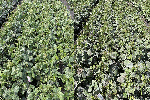Australian grain growers are advised to choose barley varieties and fungicide treatment programs carefully following the discovery of a Net blotch hybrid that is highly resistant to some Group 3 (azole or demethylase inhibitor) fungicides.
The discovery was made by researchers from the Centre for Crop and Disease Management (CCDM) - a national research centre co-supported by Curtin University and the GRDC - in collaboration with plant pathologists from the Western Australian Department of Primary Industries and Regional Development (DPIRD) and the Centre for Crop Health (CCH) at the University of Southern Queensland.
CCDM Fungicide Resistance Management and Disease Impacts Theme leader, Dr Fran Lopez-Ruiz, says not only have they discovered a fungicide resistant hybrid of the two common barley diseases Spot form net blotch (SFNB) and Net form net blotch (NFNB), the hybrid was also a clone.
A complex disease
"We've known for a couple of years that hybrids of NFNB and SFNB exist in nature," Dr Lopez-Ruiz says.
"But now, not only do we know they exist, we also know they exist with multiple genetic mutations that make them highly resistant to some Group 3 fungicides.
"On top of this, they're also genetically identical - they're clones, which means they are reproducing asexually across the Esperance and South Stirling regions."
Not only do we know they exist, we also know they exist with multiple genetic mutations that make them highly resistant to some Group 3 fungicides.
In 2017, DPIRD alerted CCDM of fungicide failure in a paddock that had been treated multiple times with formulations containing Group 3 fungicides and was thought to be infected by SFNB.
The department sent leaf samples to the CCDM and fungicide resistance tests were carried out, with the hybrid first detected from these samples.
Further samples were then tested from an additional seven sites, across the South Stirling, Frankland, Amelup and Esperance regions, with hybrid clones detected up to 350 kilometres apart.
According to CCDM researcher Wesley Mair, tests found strains of the pathogen that were not only resistant to some Group 3 fungicides, but also far more resistant than any NFNB or SFNB strain the team had ever studied.
"From further genetic analysis, we saw that this type of Net blotch carried known mutations for fungicide resistance in NFNB, and known mutations for fungicide resistance in SFNB, and after further tests we are now convinced we have discovered a highly resistant hybrid," Mr Mair says.
Tips and tactics
CCDM director, Professor Mark Gibberd, says Net blotch resistance is a focus of the Centre's research and this was another important discovery that would better inform growers and agronomists about treatment and management.
"By CCDM, DPIRD and CCH working together on these samples, we're able to build a much clearer picture of the spread and impact of Net blotch across WA - building on a range of projects our fungicide resistance experts are working on that have in-field impact," Professor Gibberd says.
Dr Lopez-Ruiz says growers in affected regions should continue with their robust integrated disease management strategies, particularly when it came to choosing varieties.
"We know the hybrid is quite virulent on Oxford, as most of the hybrid clones we have collected so far have come from infected Oxford samples," he says.
"We're looking into Planet (PBR) and La Trobe (PBR) too, as these are the only two other varieties where we have found these highly resistant strains - albeit at far lower frequencies.
"With improved knowledge of host sensitivity, it may be possible for growers to select varieties of low sensitivity - which could lead to a reduction in the population of the hybrid and slow its spread.
"However, we can't rule out the possibility that it can adapt, so we need to keep tabs on it."
Dr Lopez-Ruiz says tebuconazole and propiconazole are among the Group 3 compounds most compromised by these mutations.
Therefore, he advises their use should be avoided in solo formulations and limited when any of these two compounds are mixed with a different fungicide, especially from Group 3, as this would place extra pressure on the other mixing partner. He says the efficacies of epoxiconazole and prothioconazole are less affected.
However, we can't rule out the possibility that it can adapt, so we need to keep tabs on it.
"Other fungicide modes of action, such as those from Group 11 (QoIs) and Group 7 (SDHIs), should be in the mix too, as they remain effective at controlling these hybrids," Dr Lopez-Ruiz says.
"However, the use of SDHI fungicides should be monitored carefully given the recent discovery of SDHI resistance in NFNB in South Australia.
Dr Lopez-Ruiz discussed the Net blotch hybrid finding at the recent GRDC Grains Research Update, Perth, and papers and presentations from this event are now available on the GRDC website.
Monitor and report in season 2020
The CCDM is urging growers and advisers to report fungicide resistance in 2020.
If you suspect resistance in your paddock please contact the CCDM at frg@curtin.edu.au or ccdm@curtin.edu.au
GRDC Research Code CUR00023
More Information: Carole Kerr, CCDM, 0437 538 541, carole.kerr@curtin.edu.au;
Useful Resource: GRDC Spot Form Net Blotch Fact Sheet.


























































